How do people become so divided on issues? How do they simultaneously know so little on the subject? A grand fracture that divides. A schism in opinion on a massive scale. This article explores the dynamics of tribal divides. As this is a midflip article, please edit freely, and we will vote on any changes.
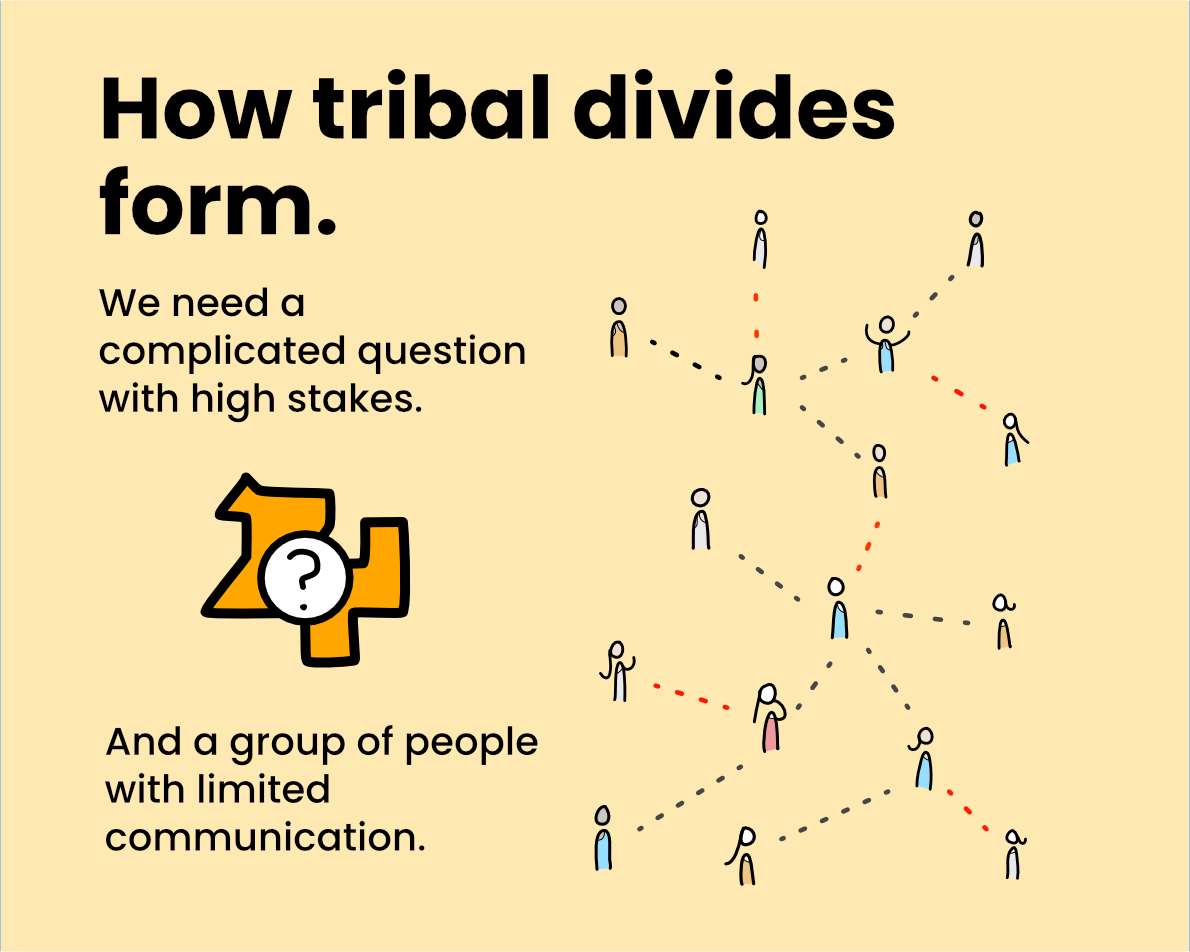
What qualities are needed for the question?
Complexity: The question is about something detailed, complicated, or nuanced.
High stakes: The consequences of choosing a specific answer is one answer over another are significant for at least some individuals.
For example: How do we deal with global warming? How do we deal with gun regulation? How do we deal with AI regulation? etc.
What qualities are needed for the group of people?
For the group, we are not considering past conflicts or individual makeup. Instead, the factor of interest is communication. How does this group communicate with each other? We claim that divisive divides are much more likely to occur when the following is true.
Communication is sparse: People talk mainly within smaller circles, not the entire group.
Limited communication channels: Communication is limited in time (like brief conversations) or with character restrictions (like social media). The more limited the communication channel, the less information can be transmitted.
Noise: Irrelevant information clogs communication channels, hindering clear understanding.
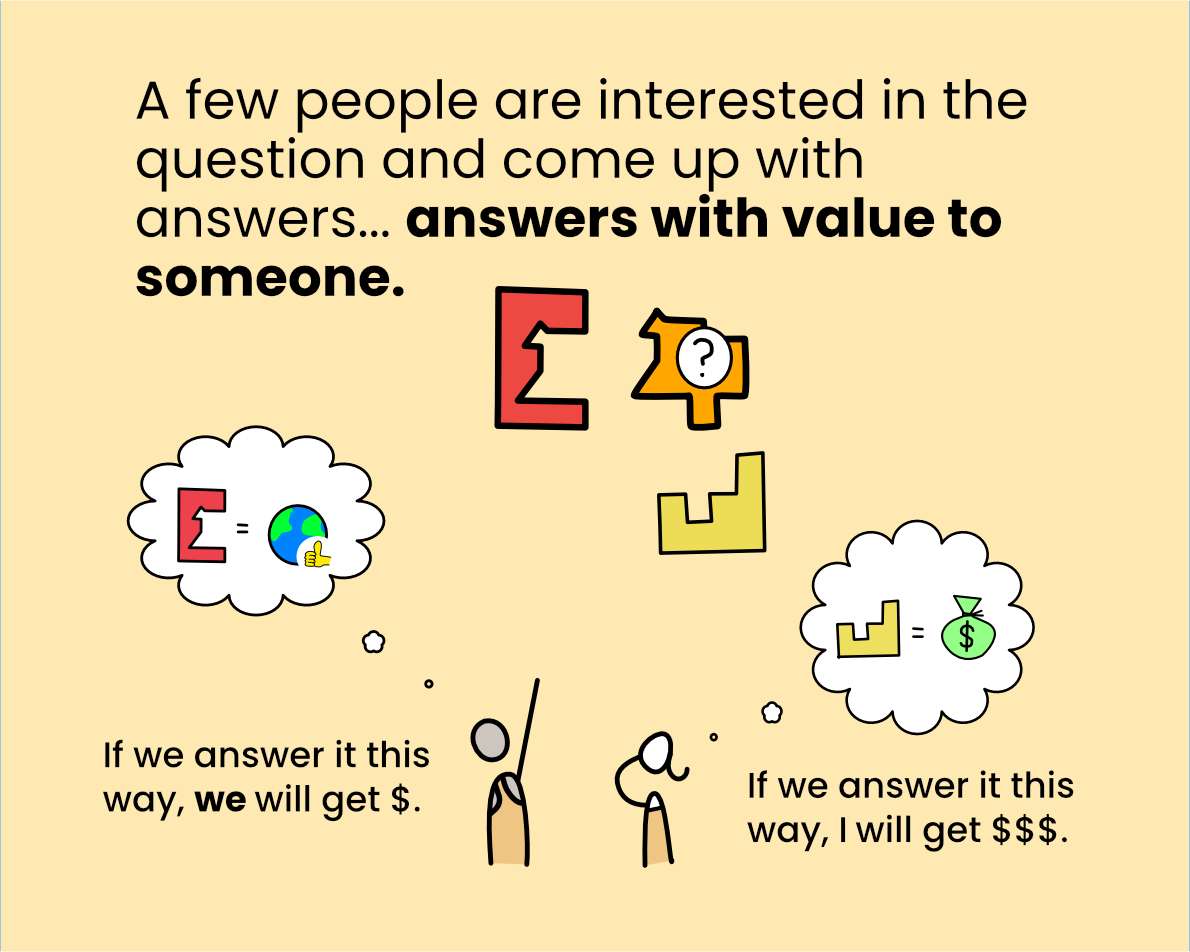
Some people explore the question
Lets imagine that currently Currently the majority of people do not care do not care about the question. They are just regular people with regular lives. Why would they care about complicated questions that do not affect them?
Instead, the question only impacts a few. Those who have an interest in how the group answers, those who see value in a particular answer.
This value need not be money related. Perhaps it is moralistic. Perhaps the question touches on preconceived notions. other preconceived notions. Regardless these few are motivated enough to explore the question and come up with an answer.
Given the value, these individuals are interested. They take time to explore the question. Their internal model of the question and the answer is rather detailed and intelligent. If these individuals talk to each other, they can intelligently see the other persons view and explore the nuance.
Now generally these individuals are interested and have taken the time to explore the question. Their internal model of the question and the answer is rather detailed and intelligent. If these individuals talk to each other, they can intelligently see the other persons view and explore the nuance.
Talking to another interested individual is nice and promotes a better understanding for both sides. However often these individuals are motivated beyond just understanding. They want to convince the group of their answer. It is from the groups answer that they will receive value.

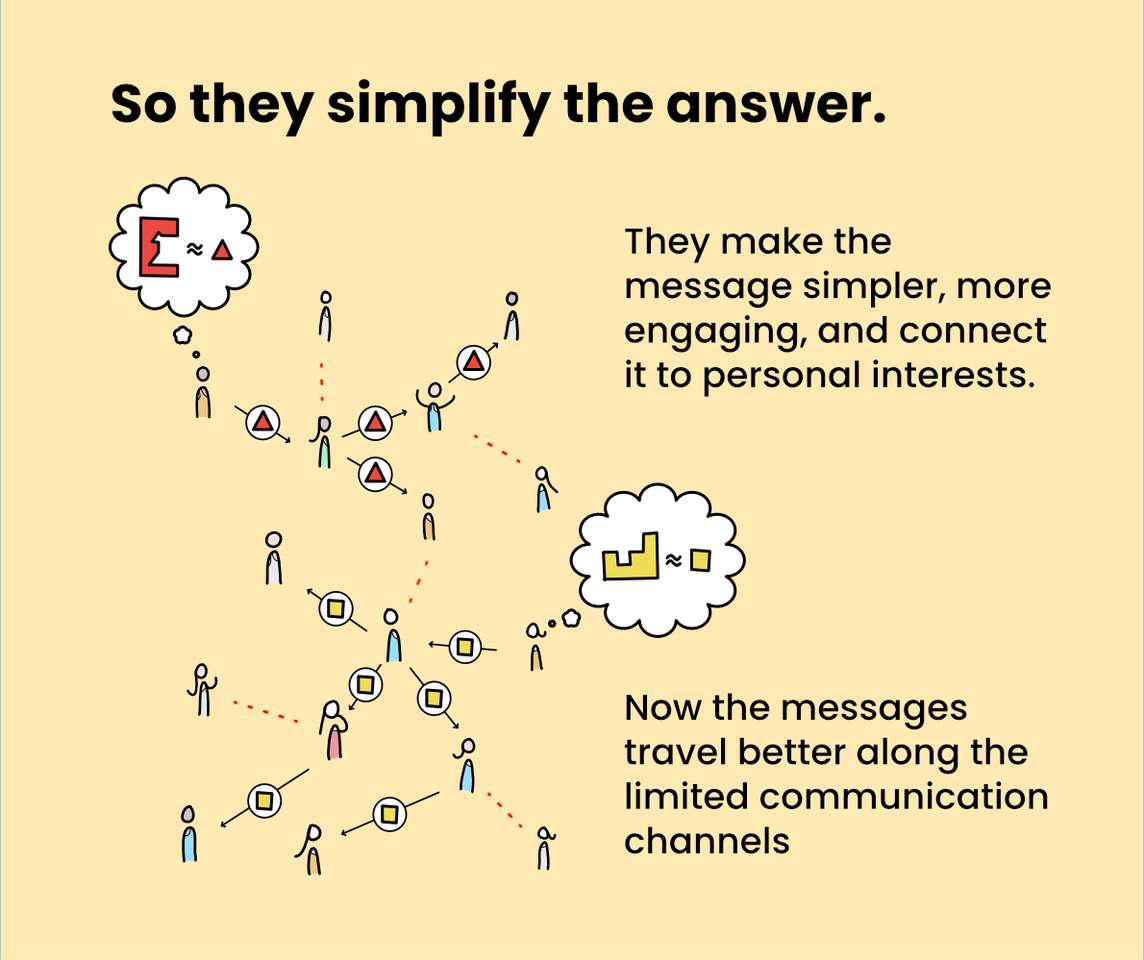
How to get the groups attention
Convincing the group is difficult for a couple of reasons. First, most people do not care about the question enough to explore it independently. Second, the communication channels are limited, sparse, and noisy. To overcome these challenges, interested individuals need to:
Simplify the message.
Make the message engaging and viral.
-
Connect the message to personal interests.
The simplified messages can be communicated. It is through these simplified messages that new people learn about the question. These individuals, who are otherwise intelligent, never really consider the question in detail because it is too complicated and nuanced. It requires significant time to contemplate. Instead, their conception of the issue is entirely based on the simplified message.
Ahh reader, you revolt! Perhaps you have a topic or question in mind. Perhaps you do contemplate it deeply. But here is the real trick. Even if a person does consider the topic deeply, the communication channels are still limited. When such a person discusses the issue with others, they have to begin with and rely on the simplified messages. All conceptualization revolves around the simplified messages because of the limited communication channels. These limitations force us to choose a simplified message as the initial foundation for our communication and understanding.
The simplified messages can be communicated. It is through these simplified messages that new people learn about the question. These individuals, who are otherwise intelligent, never really consider the question in detail because it is too complicated and nuanced. It requires significant time to contemplate. Instead, their conception of the issue is entirely based on the simplified message.
Ahh reader, you revolt! Perhaps you have a topic or question in mind. Perhaps you do contemplate it deeply. But here is the real trick. Even if a person does consider the topic deeply, the communication channels are still limited. When such a person discusses the issue with others, they have to begin with and rely on the simplified messages. All conceptualization revolves around the simplified messages because of the limited communication channels. These limitations force us to choose a simplified message as the initial foundation for our communication and understanding.
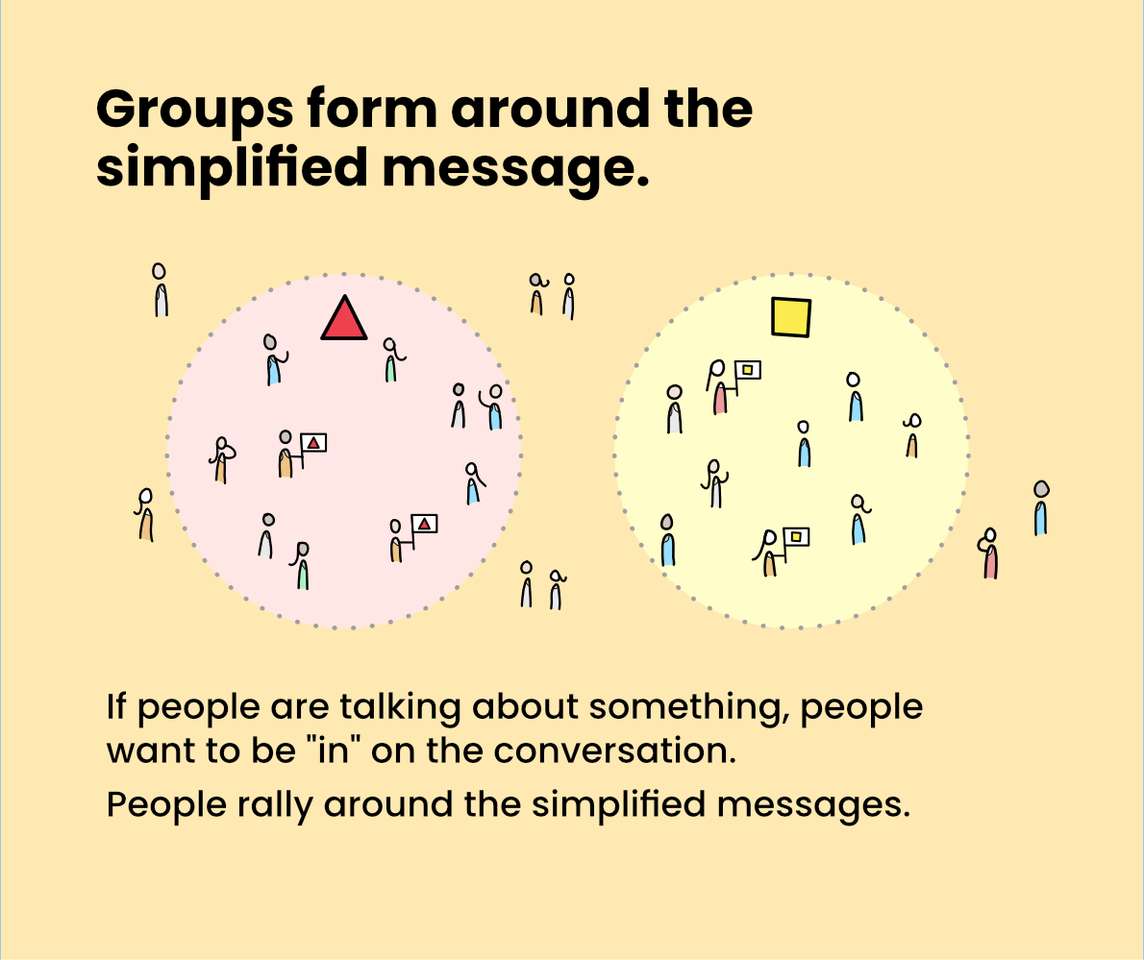
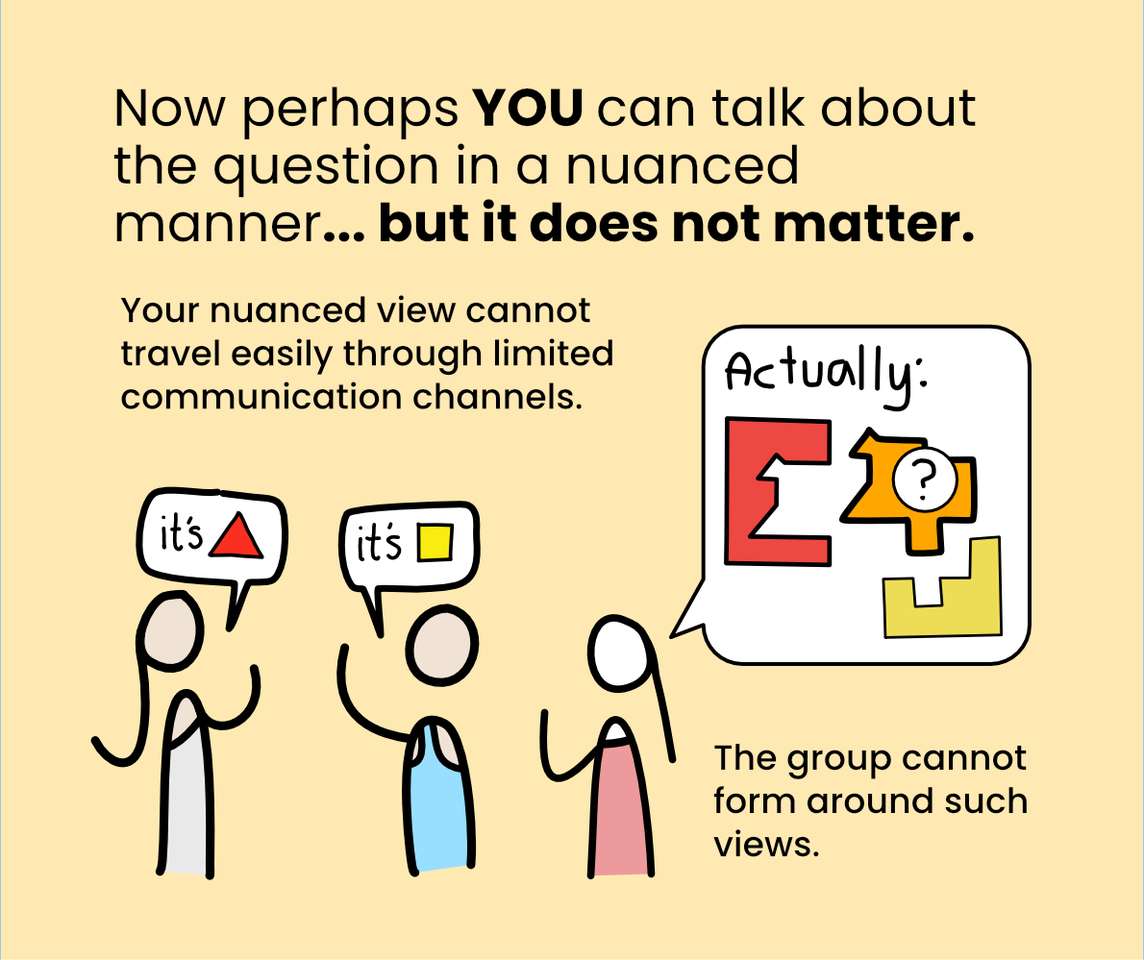

A group provides value to many different individuals.
Within these groups, you find individuals with diverse motivations:
Greater Good Advocates : These individuals have a moralistic motivation. They believe their answer to the question provides value to the larger group.
Individual Gain Pursuers : Some individuals are motivated towards an answer by the prospect of private gain.
Opportunistic Hustlers : These individuals do not care about the question or the answer. Instead, they seek secondary opportunities, such as political power, marketing, or getting attention. They may switch sides if it serves their self-interest.
Belongers : Motivated by identity, these individuals find happiness in being part of a tribe. The truth of the question is less important than the sense of belonging.
Puzzlers : These individuals are genuinely interested in the question and seek a nuanced answer. However, due to limited communication channels, they still tend to communicate the simplified message. They may switch sides if presented with compelling reason.
Note: These motivations do not encapsulate all possibilities. As humans, we often have a combination of motivations.
Each group is an ecosystem full of individual nuance, with different individuals driven by various motivations, spreading different ideas. Attention and influence can be gained within the group, and many people pursue this. Who gains such power is rather idiosyncratic. Perhaps we can say that certain questions lend themselves to specific motivations. For example, if the question is ripe with monetary incentive, the relentless efforts of the Individual Gain Pursuers may rule the day.

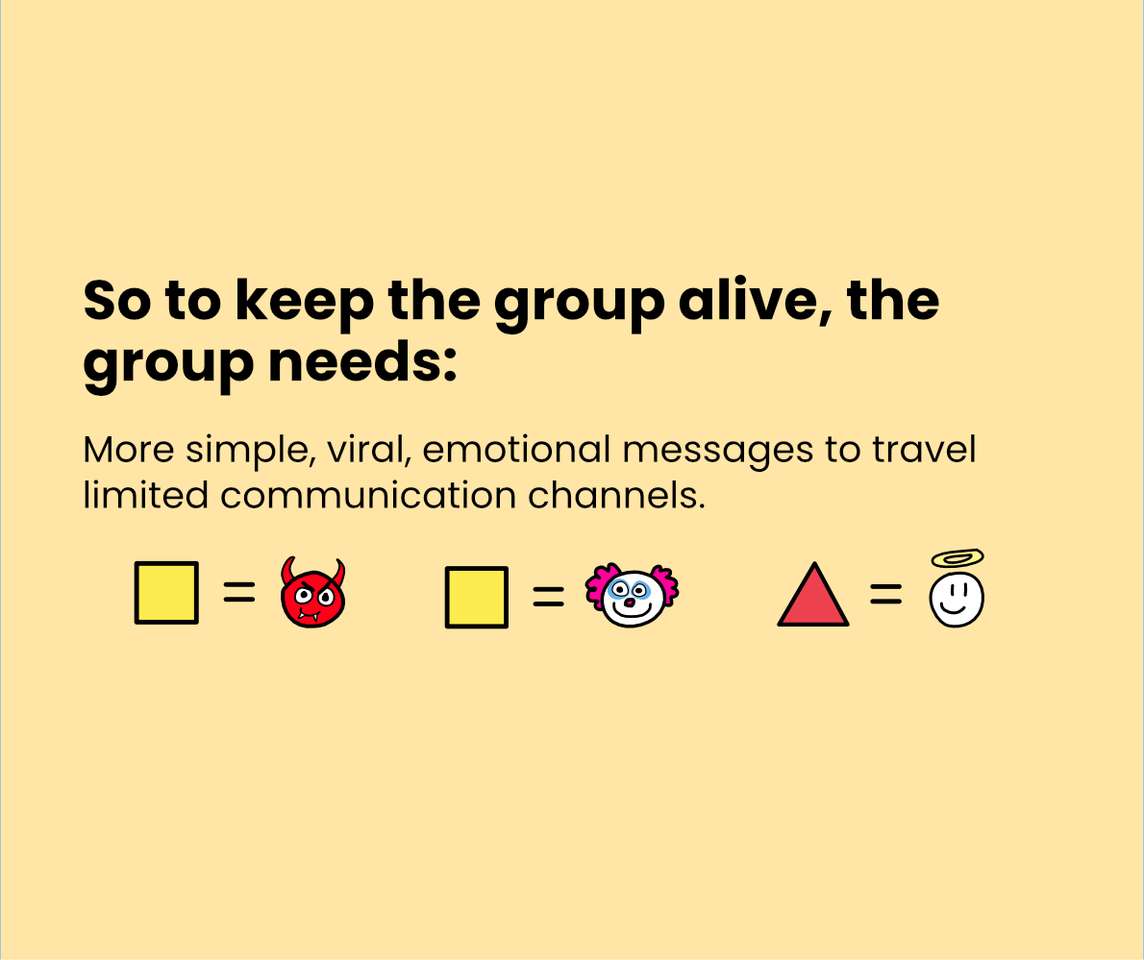
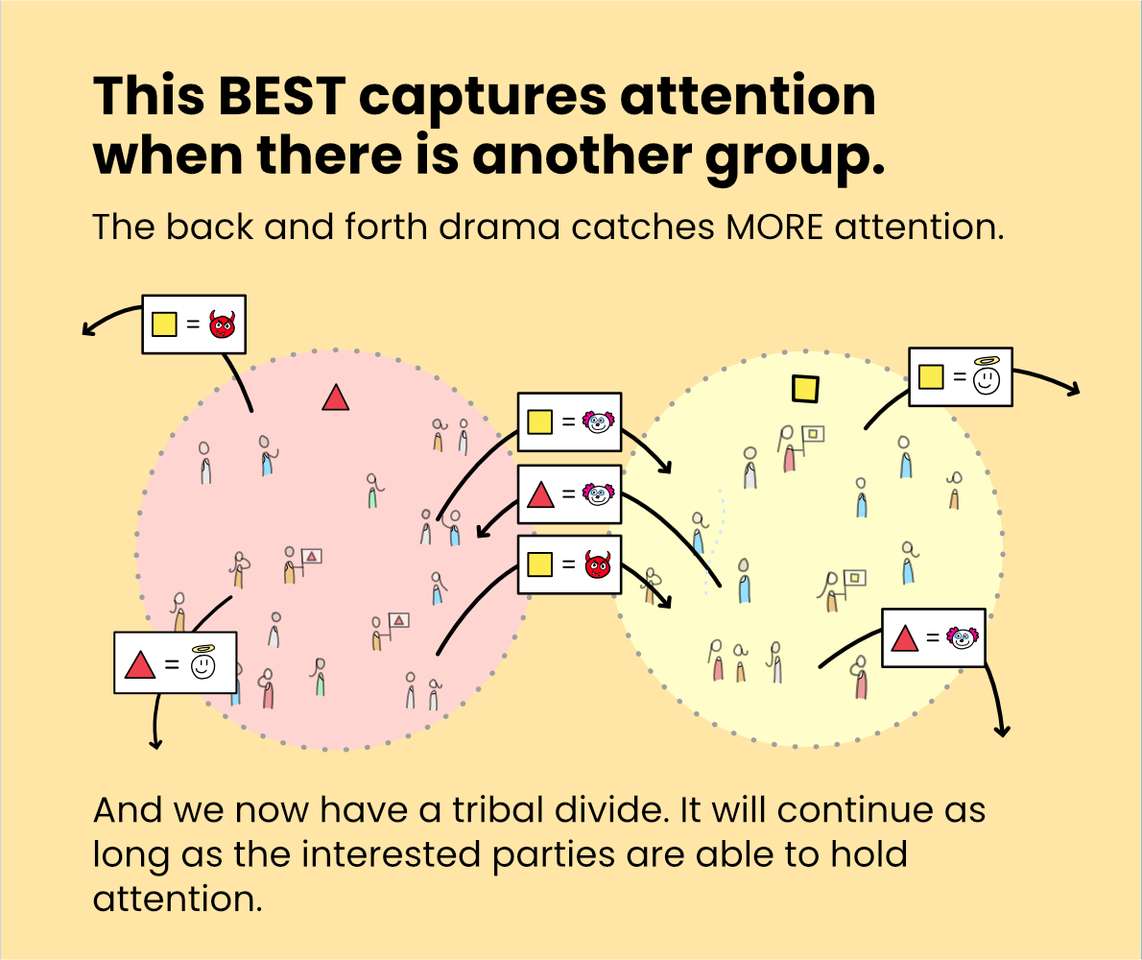
Keeping people’s attention. Keeping the group together.
Holding the attention of existing members presents a complex challenge. Delving deeper into the initial question with nuance might seem ideal. The group could turn the simplified message into an accurate model of reality. However, there are three main challenges to this direction. First and foremost, limited communication channels hinder such discussions. Second, only certain people within the group have motivations which align with this objective. Finally, (and ironically) if the question were definitively answered, the group's purpose would vanish, leading to its collapse.
Faced with these obstacles, the group must maintain attention elsewhere. Internal power struggles can be captivating, but they often fracture the group's cohesion. Instead, the most common, and perhaps most troubling, method of maintaining internal focus is through negativity towards the "outgroup." Mocking, division, and debating of outsiders solidifies the in-group bond. The "us" versus "them" dynamic becomes the beating heart of the group. However, this tactic creates a vicious cycle – the tribe needs the opposing group to exist. As is true in the other camp. Together the two-group flourish when they act like bulls and constantly ram each other.
Attracting new members presents another challenge. One that gets more difficult with time. The individuals most susceptible to the simplified message are likely the first to join. All others require more convincing. Either the message or the environment must change if viral growth is to be maintained. The message can become simpler and catchier. The environment could, perhaps with some large event, better suit the simplified message. Barring such changes, only dedicated effort in advertising or campaigning can onboard new members. The better organized and funded the group, the more capable it will be at implementing this strategy. This shared challenge can also be a source of internal solidarity.
Ironically, the internal dynamics that solidify a group also generally hinders its growth. Constant exposure to a one-sided narrative warps members' ability to see neutral perspectives. They can no longer empathize with someone outside the group on this particular issue. Besides, the in-group no longer discusses the issue in real detail… that was beyond the scope of the communication channel. Instead, the group’s internal communication has become about the out-group. Real attempts to discuss the topic become warped towards this unifying goal. External members see this more clearly than the internal mem
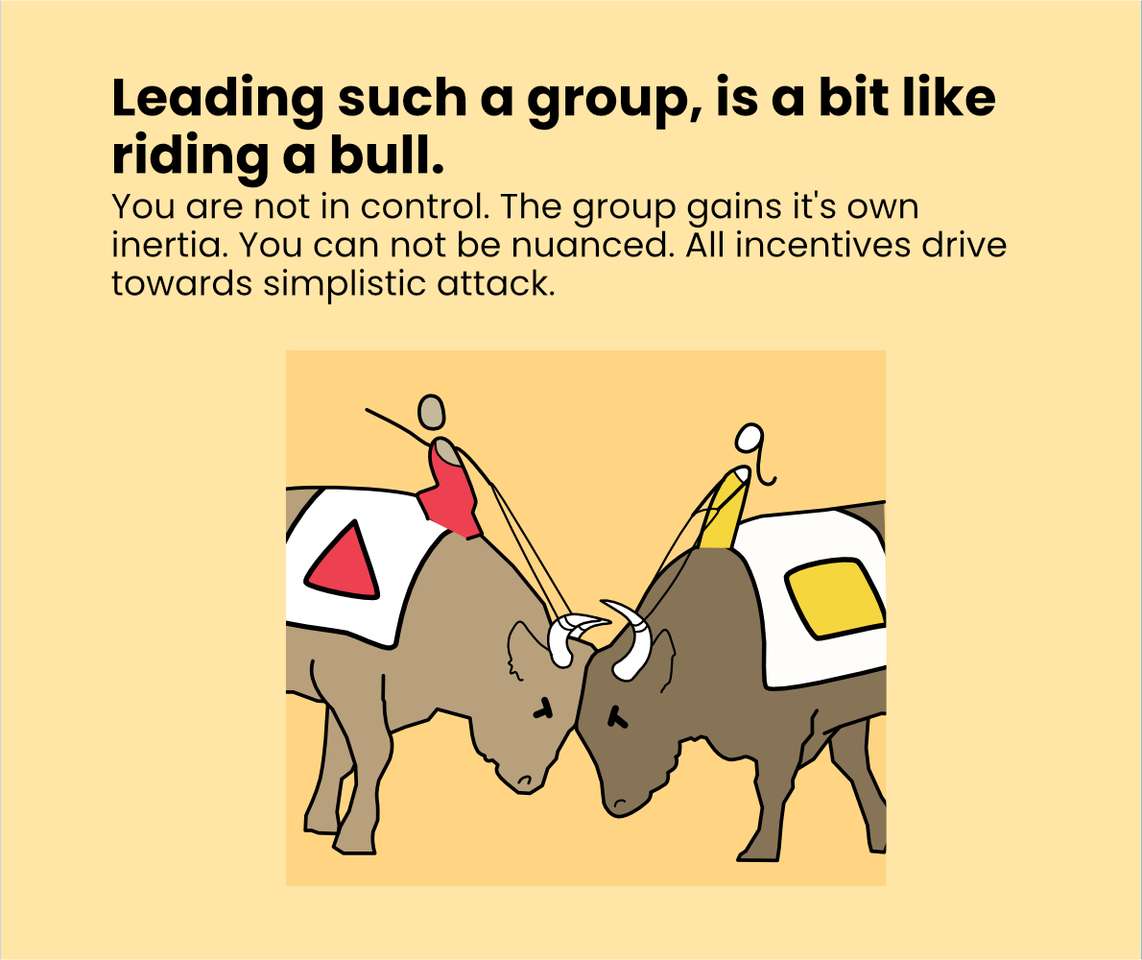
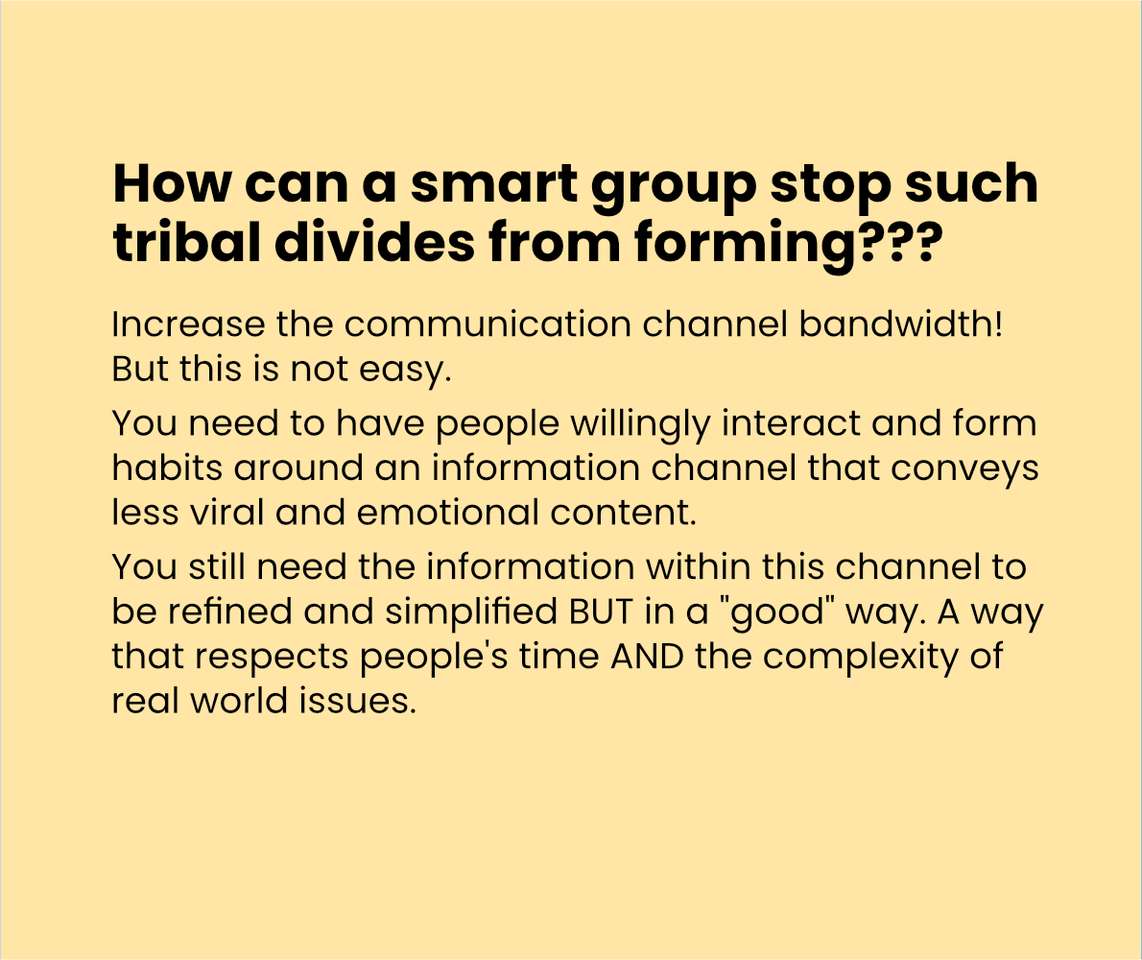
Solutions for smarter groups
So, how do we prevent ourselves from falling victim to the tribal divide? We can employ several solutions that target the root causes of the problem. The most fundamental approach is to improve the communication channels within the group. Recall the three conditions of communication channels that create tribal groupings:
Communication is sparse: People talk mainly within smaller circles, not the entire group.
Limited communication channels: Communication is limited in time (like brief conversations) or with character restrictions (like social media). The more limited the communication channel, the less information can be transmitted.
Noise: Irrelevant information clogs communication channels, hindering clear understanding.
We can design a social communication system that addresses these issues. In so doing, we can foster a more cohesive and informed group dynamic. The ideal system would center communication around specific topics, allowing the entire group to update and iterate upon a description of that topic. Communication should be allowed to lengthen to a valuable degree, while still remaining accessible to newcomers. Additionally, noise should be reduced to an optimal level, ensuring clear communication.
This design closely resembles the structure of midflip. This is no coincidence, as midflip was specifically designed to solve the problem of tribal groupings. The platform aims to make large groups smarter, enabling them to develop detailed and nuanced answers to even the most complicated and high-stakes questions.
However, improving communication channels is just one piece of the puzzle. To truly bridge the divide, we must also foster a specific culture within the group—one built on a foundation of respect for differing opinions and a commitment to truth-seeking.
In this ideal culture, we recognize that both differing opinions and the dominant narrative play crucial roles in a healthy information ecosystem. Differing opinions push us to explore new ideas and perspectives, challenging our assumptions and broadening our understanding. The dominant narrative, on the other hand, serves as a benchmark—a reference point against which we can compare and contrast our evolving knowledge. By respecting and valuing both, we create an environment that encourages exploration, growth, and the continual refinement of our shared understanding.
Be part of the solution. Use Midflip to engage in thoughtful discussions on complex topics. Share your feedback to help us continue evolving the platform. And spread the word! The details are nuanced, but the goal is simple: Midflip aims to make big groups smarter.



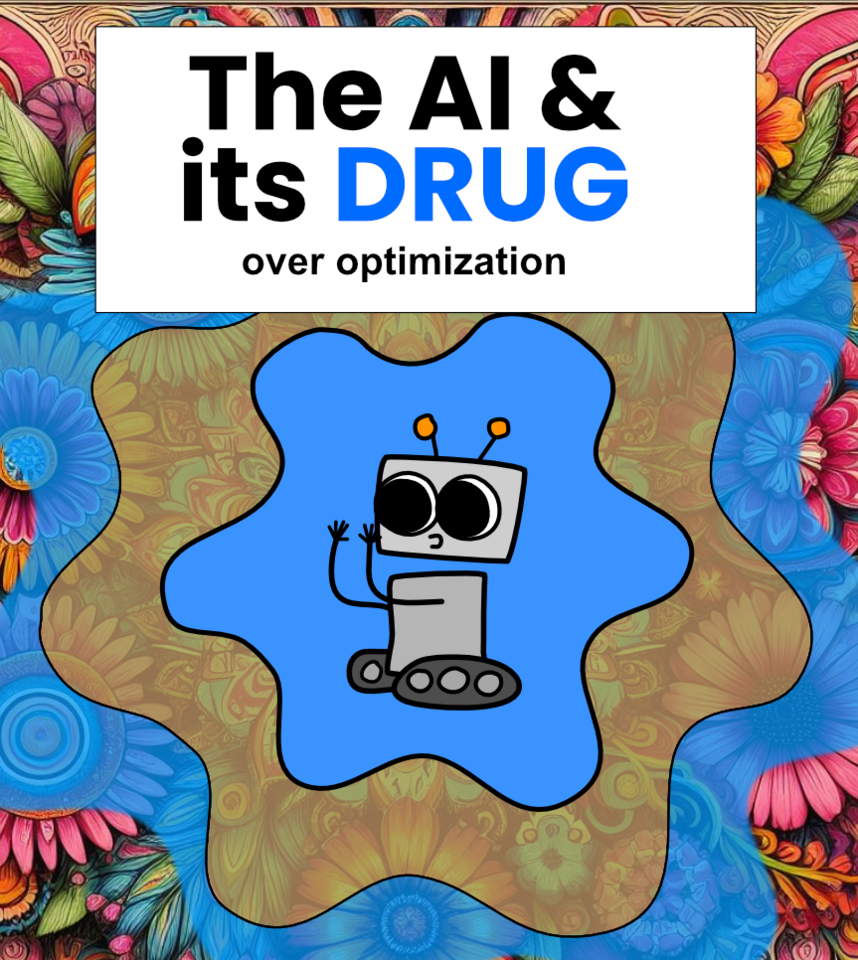


Hot comments
about anything